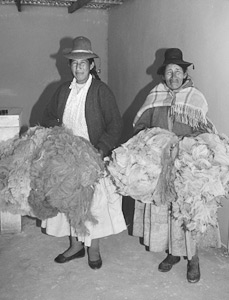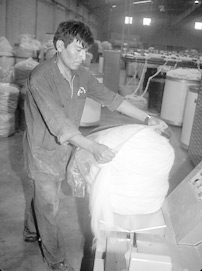Peru:
A Photographer’s Journal
Article and Photography
by Alison M. Jones
Reprinted from TechnoServe Connections, Fall 1999

Josepha Montelico and Filomena Apaza are learning from TechnoServe how to profit from their alpaca wool. TechnoServe teaches them important steps to improve the quality and the price they obtain. Such steps include shearing when the wool is the 7 cm. length needed for processing in today's machinery, rather than simply whenever they need cash.
AS a travel photograher and ardent supporter of TechnoServe, I visited its programs in Peru’s highlands (elevation 13,000 feet!) last fall. Terrorism, poverty, and inequality had devastated Peru. Now democracy, urbanization, industrialization, mass media, and cell phones are forcing major changes in just one geneeration. As a “visual anthropoligist” I’m interested in how this is affecting rural communities. On this trip, I saw that traditional Peruvian organizational skills, hard work, and inventiveness – having sustained the people thus far – are now providing a perfect platform for TechnoServe’s work. TechnoServe is helping Peruvians in the highlands to grow three types of businesses: prickly pear, alpaca wool, and cochineal bugs (harvested to produce a natural red dye).

In Arequipa, Peru, at the Internacional de Comercio, men prepare alpaca tops for sale to international wool markets.
Just as I’ve seen in East Africa and Central America, TechnoServe helps people achieve long-term financial stability, thereby improving their food security, educational opportunities, health, and housing. The end result is fortified communities. In all the villages where TechnoServe works, I have seen pride and joy sparkle in people’s eyes. In the thin, pure air of the hills behind Lake Titicaca, I again was thrilled to be a TechnoServe ambassador representing caring and serving.
|